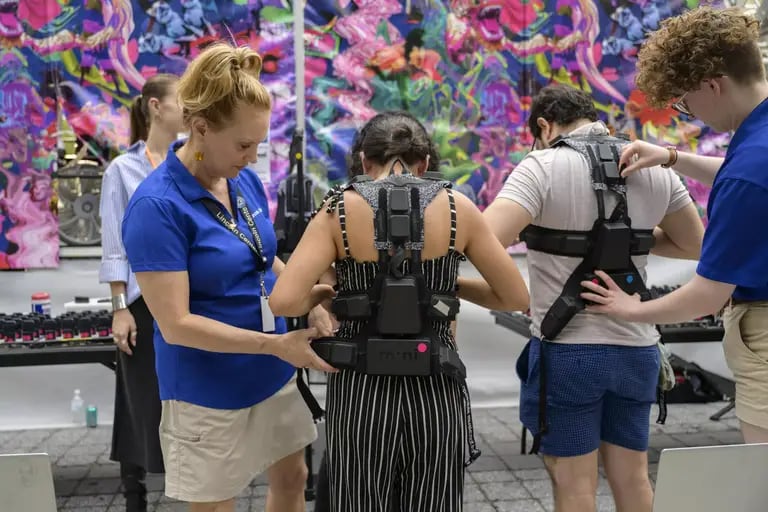Violins reverberate on the ribcage, cello and bass sit a little lower, horns on the shoulders, and most often soloists on the wrists.
That’s one of the ways that audio expert Patrick Hanlon programs the haptic suitsdesigned so that the deaf or hard of hearing can experience music without hearing it.
At a recent classical music concert at Lincoln Center in New York, some attendees put on these wireless vests with 24 vibration points that “translated” the music coming from the orchestra.
“Involves the body”, Hanlon tells AFP before the show, offering attendees a “3D immersive experience through vibrations”.
Hanlon is co-founder of Music: Not Impossible, an offshoot of Not Impossible Labs, which uses the technology to try to alleviate social barriers, including those surrounding disability.
Until nowpeople who were deaf or hard of hearing used other methods to enjoy live music, like putting your hands on the speakers or holding a balloon to feel the vibrations at your fingertips.
The purpose of the vests – along with wrist or ankle bands – is to allow a complete bodily experience, creating sensations that reproduce the feelings that music can evoke.
LOOK: Galaxy Tab S9: Samsung presents its new line of next-generation tablets
“No one expects it to be so attractivesays Hanlon about the vests. But “when you see people’s eyes, it’s magical”.
For Jay Zimmerman, a composer who lost his hearing in the terrorist attacks of September 11, 2001, the vests are an example of new technology that offers more flexibility and dynamism than has been the case before.
“My hope is that we can get deaf children to live experiences with vibrations and real materials, so that they begin to build this library of auditory memory, even if it is not auditory through their ears, but with different sensations.”, he tells AFP.
“I think if we can put it all together, we’ll have real opportunities.”.
LOOK: Aspire Vero 2023: we review the Acer laptop that is made with recycled plastic | REVIEW
– “Immersion” –
Lincoln Center, the prestigious complex on the Upper West Side of Manhattan, began working with Music: Not Impossible in 2021, both for the orchestra shows and for its popular outdoor concert series.
In their most recent collaboration they offered 75 vests during the Korean Arts Week open-air concert featuring Korean folk music and Mozart Concerto No. 2.

Liza Fiol-Matta was one of the attendees, and although she is not hard of hearing, she was intrigued by this new technology.
“I love music”, he says and the “idea that anyone can feel it” it’s exciting, even “the deaf and hearing impaired”.
“I love the idea of immersion, of any immersive experience. Music occurs at many different levels“, says.
Flavia Naslausky, business manager for Music: Not Impossible, described how during early tests, Mandy Harvey – a singer who lost her hearing after illness – he was able to match the sound of the music after feeling the vibration that translated it.
LOOK: How BMW smart glasses work for motorcycle travel with Head-Up Display and GPS
“That’s when we knew we were right, because if someone who doesn’t hear can match that note with a vibration… we’re in the right direction.Naslausky said.
The vests of this company are not limited to one type of music. Hanlon explains that the vibration points can be adjusted to suit the mood of a performance, from rock to disco.
These vests have already been used at concerts by Greta Van Fleet and Lady Gaga.
LOOK: Apple would already be developing its first folding MacBook, according to rumors
Zimmerman is excited about the potential of the technology, but He is aware that there is still a long way to go.
“Ultimately, the big goal for me is that I will be able to feel a smooth violin and it will be so beautiful to my body and mind that it would make me cry.”comment. “And I’ll be able to feel that same note through a burst of trombone that will be so hilarious I’ll laugh.””.
“That’s the big dream”, he concludes.

Source: Elcomercio
I have worked in the news industry for over 10 years. I have a vast amount of experience in writing and reporting. I have also worked as an author for a number of years, writing about technology and other topics.
I am a highly skilled and experienced journalist, with a keen eye for detail. I am also an excellent communicator, with superb writing skills. I am passionate about technology and its impact on our world. I am also very interested in current affairs and the latest news stories.
I am a hardworking and dedicated professional, who always strives to produce the best possible work. I am also a team player, who is always willing to help out others.

:quality(75)/cloudfront-us-east-1.images.arcpublishing.com/elcomercio/2BCPRC5V4NBSDGXMWBCZLIX6XA.png)





